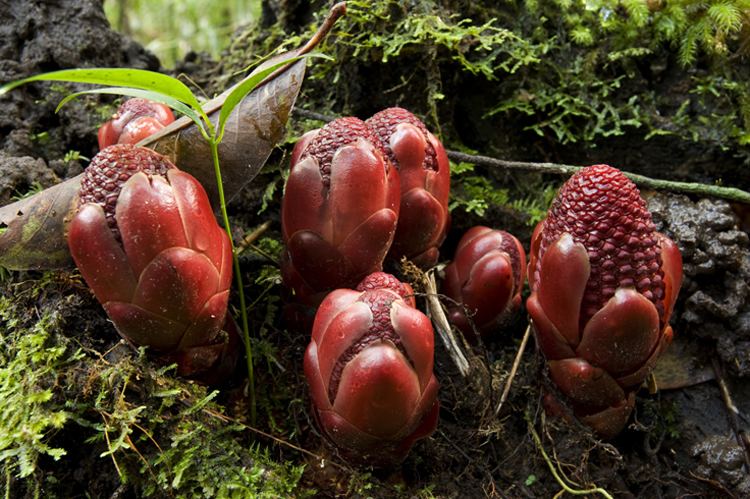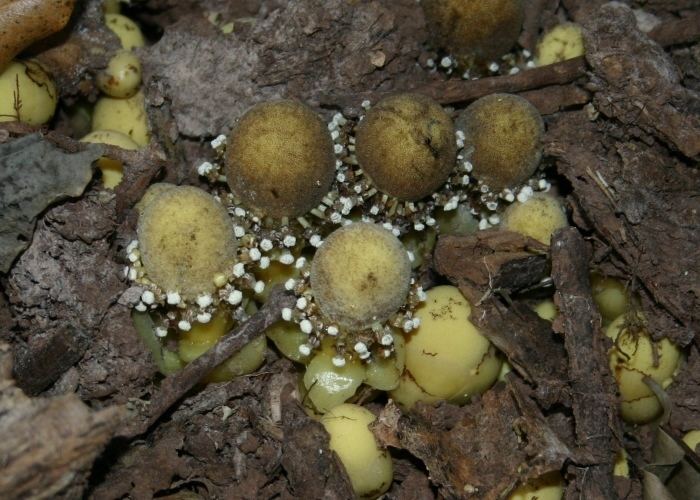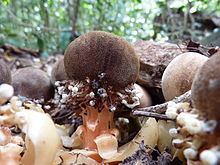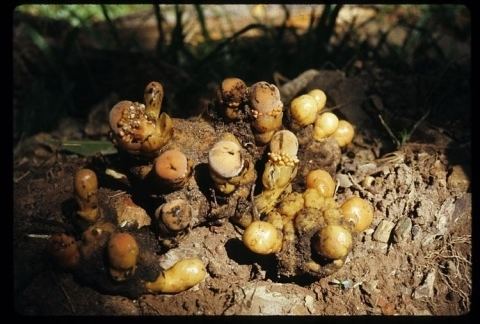Rank Species | Genus Balanophora | |
Similar Balanophora, Balanophoraceae, Balanophora laxiflora, Balanophora tobiracola, Langsdorffia | ||
Balanophora fungosa, sometimes known as fungus root is a flowering plant in the family Balanophoraceae and occurs in South Asia, Southeast Asia, Australia and some Pacific Islands. It is an obligate parasite growing on the roots of rainforest trees. The flowering structure is shaped like a puffball but in fact consists of a globe covered with thousands of tiny female flowers. The globe is surrounded at its base by a much smaller number of male flowers. In flower, the plant emits an odour resembling that of mice.
Contents

Description
Like other members of its genus, B. fungosa is holoparasitic and contains no chlorophyll. The aerial parts of the plant consist of a hard, irregularly shaped tuber from which the flower-bearing structures extend. The leaves are scale-like, pale cream in colour, 8–30 millimetres (0.3–1 in) long, 7–20 millimetres (0.3–0.8 in) wide and more or less stem clasping.

The plant is monoecious, bearing both pistillate (female) and staminate (male) flowers. Thousands of minute female flowers cover a globe-shaped structure 15–20 millimetres (0.6–0.8 in) in diameter. The styles are less than 1 millimetre (0.04 in) long. About 20 male flowers are arranged around the base of the globe, each about 3–5 millimetres (0.1–0.2 in) in diameter with a pedicel about 5–6 millimetres (0.20–0.24 in) and are covered with powdery white pollen.
Taxonomy and naming

Balanophora fungosa was described by Johann Reinhold Forster and Georg Forster in 1774 and the description was published in Characteres Generum Plantarum. The specific epithet (fungosa) is a Latin word meaning "full of holes" or "spongy".
There are two subspecies–
Distribution and habitat
Balanophora fungosa is found in coastal forests from near sea level to 900 metres (3,000 ft) in Australia, Taiwan, Indonesia, Ryukyu Islands, New Guinea, the Philippines, some Pacific Islands, India and Cambodia. In Australia it occurs in Queensland from near the border with New South Wales to Cape York.
Ecology
Twelve species of plant in eight families are known to be hosts to Balanophora fungosa var. indica including some of those in the genera Syzygium, Olea and Rapanea. The plant is sometimes a weed in coffee and tea plantations.

Numerous small animals visit the flowers, including ants, springtails, flies, a moth of the family noctuidae, and even rats, which appear to be attracted by the smell. Workers of the Asiatic honeybee, Apis cerana have been observed collecting pollen. Two beetle species of the genus Lasiodactylus, a moth of the family Pyralidae and a moth of the family Tipulidae use the bracts at the base of the flowers as a breeding site.
Use as medicine
Some cultures, such as the Paliar people of Tamil Nadu, use B. fungosa to treat medical conditions.

